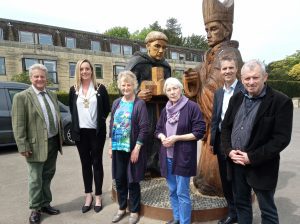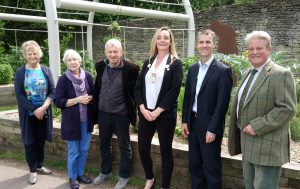They mark the handover from the Abbey 900 Legacy Project Team of the Abbott and Canon Statues and the Monastic Garden to Cirencester Town Council. The Mayor of Cirencester, Councillor Claire Bloomer (Wardell) on behalf of Cirencester Town Council, officiated.
The project was funded by monies raised during the yearlong Festival in 2017 to mark 900 years since the building of St Mary’s Abbey began in 1117. The statues depict an imperious Abbott – the monastery was known for its control of the townspeople as well as its charitable works and a working canon.
The garden’s planting is reminiscent of the herbs the canons would have grown for culinary and medicinal purposes and the hops used for the making of their beer. It is also intended as a sensory garden for the enjoyment of all, today.

The Earl Bathurst, Councillor Claire Bloomer (Mayor), Corinne Lamus (Chair, Abbey 900 Festival 2017), Councillor Jan Gronow, Charles Woodd (Chair Abbey 900 Legacy Project Team) and Martin Portus, Project Leader for the Legacy Project.
It is intended to enhance the gift of the Abbey Grounds and to provide talking points to raise awareness of the role of the Abbey in Cirencester’s history. The very important and large Abbey stood in the Abbey Grounds and played a large part in the life of the town for over 400 years until the dissolution of the monasteries and was itself dissolved in 1539.
Pictured: Corinne Lamus (Chair, Abbey 900 Festival 2017), Councillor Jan Gronow, Martin Portus, Project Leader for the Legacy Project. Councillor Claire Bloomer (Mayor), Charles Woodd (Chair Abbey 900 Legacy Project Team) and The Earl Bathurst.
The 2017 Festival also provided a legacy of ongoing community spirit and the model of the Abbey made of 70,000 LEGO bricks that was built by residents and visitors to the town during the year. The model is a depiction of how the Abbey might have looked in the 1400s and can be found in the Parish Church of St John Baptist in the Market Place in Cirencester

